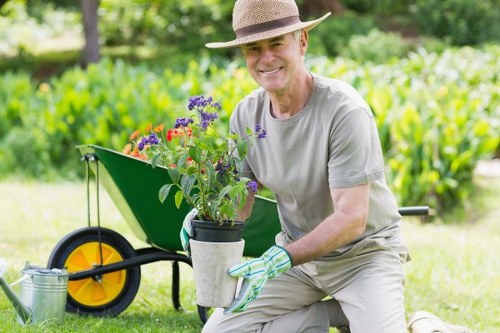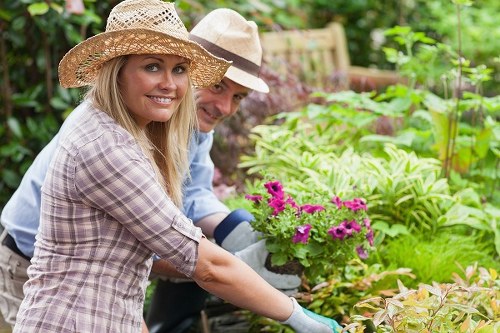Garden Maintenance in Shadwell
Introduction to Garden Maintenance

Maintaining a beautiful garden in Shadwell requires dedication, knowledge, and the right strategies. Whether you're a seasoned gardener or a novice, understanding the basics of garden maintenance can transform your outdoor space into a thriving oasis.
Shadwell's unique climate and soil conditions make it essential to tailor your gardening practices to suit the environment. From selecting the right plants to implementing effective maintenance routines, every decision impacts the health and beauty of your garden.
In this article, we'll explore comprehensive garden maintenance techniques tailored specifically for Shadwell. We'll cover essential topics such as soil preparation, plant selection, pest control, and seasonal care to ensure your garden remains vibrant year-round.
Understanding Shadwell's Climate and Soil

Shadwell experiences a temperate climate with distinct seasons, which influences the types of plants that can thrive here. Summers are warm and moderately humid, while winters are cool with occasional frost. Understanding these climate patterns is crucial for selecting plants that can withstand local conditions.
The soil in Shadwell is predominantly clay-based, which retains moisture but can lead to poor drainage if not managed properly. Amending the soil with organic matter such as compost or well-rotted manure can improve its structure, enhancing both drainage and nutrient availability for plants.
Regular soil testing is recommended to determine pH levels and nutrient content. Most plants prefer a slightly acidic to neutral pH (6.0-7.0). Adjusting the soil pH by adding lime or sulfur can create an optimal environment for plant growth.
Plant Selection for Shadwell Gardens

Choosing the right plants is the foundation of successful garden maintenance in Shadwell. Opt for native species and those adapted to the local climate and soil conditions. Native plants typically require less maintenance, are more resistant to pests, and contribute to the local ecosystem's health.
Consider incorporating a mix of perennials, annuals, shrubs, and trees to create a diverse and resilient garden. Perennials like lavender and rosemary not only add beauty but also attract beneficial pollinators. Shrubs such as boxwood provide structure, while deciduous trees offer shade and seasonal interest.
When selecting plants, pay attention to their light and water requirements. Grouping plants with similar needs together can simplify maintenance and ensure each plant receives the appropriate care.
Soil Preparation and Fertilization

Proper soil preparation is essential for healthy plant growth. Begin by removing weeds and debris from the garden area. Loosen the soil to a depth of at least 12 inches to promote root penetration and improve aeration.
Incorporate organic matter such as compost or peat moss to enhance soil fertility and structure. Organic fertilizers release nutrients slowly, providing a steady supply of essentials like nitrogen, phosphorus, and potassium to your plants.
It's important to fertilize your garden based on plant needs and soil conditions. Over-fertilization can lead to nutrient imbalances, while under-fertilization may result in stunted growth and poor plant health. Regularly monitor your garden's nutrient levels and adjust your fertilization schedule accordingly.
Watering Practices for Optimal Growth

Efficient watering is a cornerstone of effective garden maintenance. In Shadwell, it's important to balance water usage to prevent both drought stress and waterlogging. Early morning is the best time to water your garden, reducing evaporation and allowing plants to absorb moisture throughout the day.
Implementing drip irrigation systems or soaker hoses can help deliver water directly to the plant roots, minimizing waste and reducing the risk of fungal diseases. Mulching around plants also helps retain soil moisture, suppress weeds, and regulate soil temperature.
Adjust your watering schedule based on seasonal changes and rainfall patterns. During hotter months, plants may require more frequent watering, while rainfall can reduce the need for supplemental irrigation.
Pest and Disease Management
Maintaining a Healthy GardenPests and diseases are common challenges in garden maintenance. Regular monitoring is key to early detection and effective management. Identify common pests in Shadwell, such as aphids, slugs, and caterpillars, and implement appropriate control measures.
Use integrated pest management (IPM) practices to minimize the impact of pests while reducing reliance on chemical pesticides. This includes promoting beneficial insects, using barriers and traps, and selecting pest-resistant plant varieties.
Preventing diseases involves maintaining good garden hygiene, such as removing dead plant material and ensuring proper air circulation. Avoid overwatering, which can create favorable conditions for fungal infections.
Pruning and Trimming Techniques

Regular pruning and trimming are essential for maintaining plant health and appearance. Pruning helps remove dead or diseased branches, encourages new growth, and shapes plants for optimal aesthetics.
Different plants require specific pruning techniques. For instance, flowering shrubs may need to be pruned after blooming to ensure the next season's flowers, while fruit trees benefit from annual pruning to enhance fruit production and tree structure.
Use sharp, clean tools to make precise cuts, reducing the risk of infection and promoting faster healing. Always follow the recommended pruning guidelines for each plant species to avoid damaging them.
Seasonal Garden Care

Adapting your garden maintenance routines to the changing seasons ensures year-round vitality. In spring, focus on planting new blooms, fertilizing, and preparing the garden for the growing season.
Summer maintenance includes regular watering, mulching, and monitoring for pests and diseases. As temperatures rise, provide adequate shade and ventilation for sensitive plants.
Autumn is the time to clean up fallen leaves, plant bulbs for spring, and prepare perennials for the colder months. Winter maintenance involves protecting plants from frost, pruning dormant trees, and planning for the next gardening season.
Tools and Equipment for Garden Maintenance

Having the right tools can make garden maintenance more efficient and enjoyable. Essential tools for a Shadwell garden include:
- Pruning Shears: For precise cutting of branches and stems.
- Garden Fork: Ideal for loosening soil and removing weeds.
- Rakes: Useful for leveling soil and gathering leaves.
- Watering Equipment: Drip irrigation systems or soaker hoses for efficient watering.
- Gloves: To protect your hands while working in the garden.
Investing in high-quality, durable tools can save time and effort, making garden maintenance tasks easier and more effective.
Creating a Sustainable Garden

Sustainability is increasingly important in garden maintenance. Implementing eco-friendly practices not only benefits the environment but can also reduce maintenance efforts. Some sustainable gardening tips for Shadwell include:
- Composting kitchen and garden waste to create nutrient-rich soil amendments.
- Using organic fertilizers and pest control methods to minimize chemical usage.
- Planting native species that require less water and are more resistant to local pests.
- Rainwater harvesting to supplement irrigation needs.
- Incorporating biodiversity by planting a variety of species to support beneficial insects and wildlife.
By adopting sustainable practices, you can create a garden that is both beautiful and environmentally responsible.
Professional Garden Maintenance Services

While DIY garden maintenance is rewarding, sometimes hiring professional gardeners in Shadwell can ensure your garden receives the expert care it deserves. Professional services offer comprehensive maintenance, including soil analysis, plant health assessments, and customized care plans tailored to your garden's specific needs.
Professionals have the experience and knowledge to tackle complex gardening challenges, such as pest infestations, disease outbreaks, and landscape design. They can also save you time, allowing you to enjoy your garden without the hassle of constant upkeep.
Consider consulting with a local garden maintenance service to discuss your garden's requirements and explore the benefits of professional care.
Conclusion and Next Steps
Effective garden maintenance in Shadwell involves a combination of proper planning, regular care, and sustainable practices. By understanding the local climate and soil conditions, selecting appropriate plants, and implementing strategic maintenance routines, you can cultivate a thriving and beautiful garden.
Whether you choose to maintain your garden yourself or seek professional assistance, the key is consistency and attention to detail. Start by assessing your garden's current state, identifying areas for improvement, and setting achievable maintenance goals.
Contact us today to learn more about tailored garden maintenance solutions designed to keep your Shadwell garden in optimal condition all year round.

